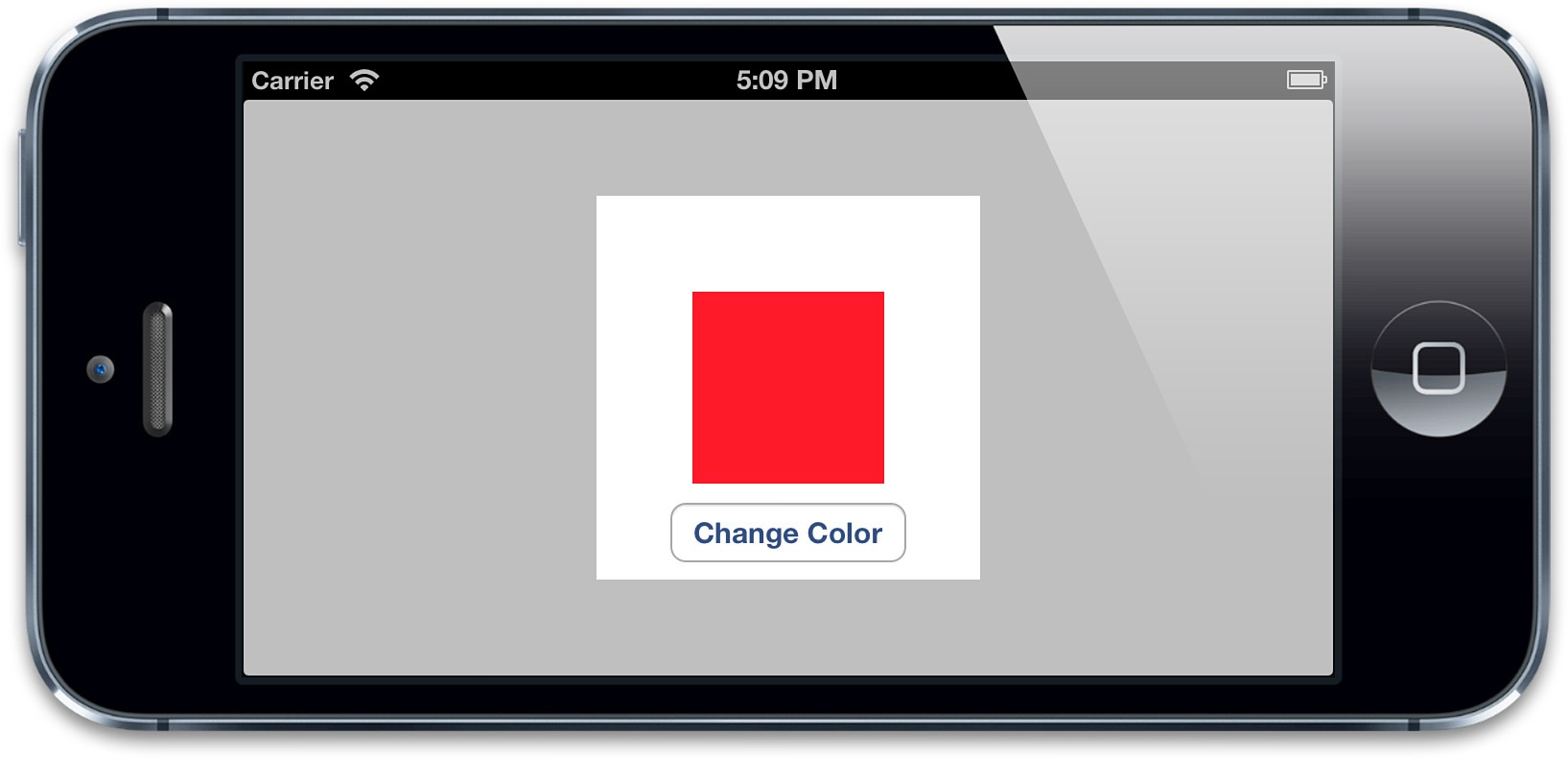Core Animation基于一个假设,说屏幕上的任何东西都可以(或者可能)做动画。动画并不需要你在Core Animation中手动打开,相反需要明确地关闭,否则他会一直存在。
当你改变CALayer的一个可做动画的属性,它并不能立刻在屏幕上体现出来。相反,它是从先前的值平滑过渡到新的值。这一切都是默认的行为,你不需要做额外的操作。
这看起来这太棒了,似乎不太真实,我们来用一个demo解释一下:首先和第一章“图层树”一样创建一个蓝色的方块,然后添加一个按钮,随机改变它的颜色。代码见清单7.1。点击按钮,你会发现图层的颜色平滑过渡到一个新值,而不是跳变(图7.1)。
清单7.1 随机改变图层颜色
1 @interface ViewController () 2 3 @property (nonatomic, weak) IBOutlet UIView *layerView; 4 @property (nonatomic, weak) IBOutlet CALayer *colorLayer;/*热心人发现这里应该改为@property (nonatomic, strong) CALayer *colorLayer;否则运行结果不正确。 5 */ 6 @end 7 8 @implementation ViewController 9 10 - (void)viewDidLoad 11 { 12 [super viewDidLoad]; 13 //create sublayer 14 self.colorLayer = [CALayer layer]; 15 self.colorLayer.frame = CGRectMake(50.0f, 50.0f, 100.0f, 100.0f); 16 self.colorLayer.backgroundColor = [UIColor blueColor].CGColor; 17 //add it to our view 18 [self.layerView.layer addSublayer:self.colorLayer]; 19 } 20 21 - (IBAction)changeColor 22 { 23 //randomize the layer background color 24 CGFloat red = arc4random() / (CGFloat)INT_MAX; 25 CGFloat green = arc4random() / (CGFloat)INT_MAX; 26 CGFloat blue = arc4random() / (CGFloat)INT_MAX; 27 self.colorLayer.backgroundColor = [UIColor colorWithRed:red green:green blue:blue alpha:1.0].CGColor; ? 28 } 29 30 @end

图7.1 添加一个按钮来控制图层颜色
这其实就是所谓的隐式动画。之所以叫隐式是因为我们并没有指定任何动画的类型。我们仅仅改变了一个属性,然后Core Animation来决定如何并且何时去做动画。Core Animaiton同样支持显式动画,下章详细说明。
但当你改变一个属性,Core Animation是如何判断动画类型和持续时间的呢?实际上动画执行的时间取决于当前事务的设置,动画类型取决于图层行为。
事务实际上是Core Animation用来包含一系列属性动画集合的机制,任何用指定事务去改变可以做动画的图层属性都不会立刻发生变化,而是当事务一旦提交的时候开始用一个动画过渡到新值。
事务是通过CATransaction类来做管理,这个类的设计有些奇怪,不像你从它的命名预期的那样去管理一个简单的事务,而是管理了一叠你不能访问的事务。CATransaction没有属性或者实例方法,并且也不能用+alloc和-init方法创建它。但是可以用+begin和+commit分别来入栈或者出栈。
任何可以做动画的图层属性都会被添加到栈顶的事务,你可以通过+setAnimationDuration:方法设置当前事务的动画时间,或者通过+animationDuration方法来获取值(默认0.25秒)。
Core Animation在每个run loop周期中自动开始一次新的事务(run loop是iOS负责收集用户输入,处理定时器或者网络事件并且重新绘制屏幕的东西),即使你不显式的用[CATransaction begin]开始一次事务,任何在一次run loop循环中属性的改变都会被集中起来,然后做一次0.25秒的动画。
明白这些之后,我们就可以轻松修改变色动画的时间了。我们当然可以用当前事务的+setAnimationDuration:方法来修改动画时间,但在这里我们首先起一个新的事务,于是修改时间就不会有别的副作用。因为修改当前事务的时间可能会导致同一时刻别的动画(如屏幕旋转),所以最好还是在调整动画之前压入一个新的事务。
修改后的代码见清单7.2。运行程序,你会发现色块颜色比之前变得更慢了。
清单7.2 使用CATransaction控制动画时间
1 - (IBAction)changeColor 2 { 3 //begin a new transaction 4 [CATransaction begin]; 5 //set the animation duration to 1 second 6 [CATransaction setAnimationDuration:1.0]; 7 //randomize the layer background color 8 CGFloat red = arc4random() / (CGFloat)INT_MAX; 9 CGFloat green = arc4random() / (CGFloat)INT_MAX; 10 CGFloat blue = arc4random() / (CGFloat)INT_MAX; 11 self.colorLayer.backgroundColor = [UIColor colorWithRed:red green:green blue:blue alpha:1.0].CGColor; 12 ?//commit the transaction 13 [CATransaction commit]; 14 }
如果你用过UIView的动画方法做过一些动画效果,那么应该对这个模式不陌生。UIView有两个方法,+beginAnimations:context:和+commitAnimations,和CATransaction的+begin和+commit方法类似。实际上在+beginAnimations:context:和+commitAnimations之间所有视图或者图层属性的改变而做的动画都是由于设置了CATransaction的原因。
在iOS4中,苹果对UIView添加了一种基于block的动画方法:+animateWithDuration:animations:。这样写对做一堆的属性动画在语法上会更加简单,但实质上它们都是在做同样的事情。
CATransaction的+begin和+commit方法在+animateWithDuration:animations:内部自动调用,这样block中所有属性的改变都会被事务所包含。这样也可以避免开发者由于对+begin和+commit匹配的失误造成的风险。